Ace Products LNER(BR) A3
Prepared by Tommy Day
Originator Sandy Harper
| Failed to open database: gaugegu1_gog2 | ret is false |
.A speculative bid on fleabay saw me win a Ace Loco kit for an A3 It came with a complete Premier Components chassis and valve gear kit as an extra, so I considered it to be good value.
I don't model the LNER so I am on quite a steep learning curve with this one. The kit was for the loco only so I still have to source a tender for it and I am presently leaning towards the ex GN eight wheeled version but that is a while away yet.
I had originally intended to build the Premier chassis but after putting it together I had a change of mind when I realised the additional work involved in adapting it to fit the Ace body and running gear, so I decided instead to stick with the Ace chassis and see how that went together first. I could always revert later!
I decided to build the chassis with float and springing in the middle driving axle and elongated the bearing holes to suit. The prepared chassis sides, with the front, centre and rear driving bearings still loose, were then set up in the Hobby Holidays Chassis Jig and the spacers and bearings for the two outer axles soldered in.
The chassis is designed to have the rear extensions tapered and the front part narrowed behind the bogie wheels, as can be seen in the photographs, and they were carefully bent to shape and the narrower spacers for them soldered in.
I would like to make the valve gear/cylinders and motion brackets detachable in case I decide to revert to the brass chassis, so that will be my next project.
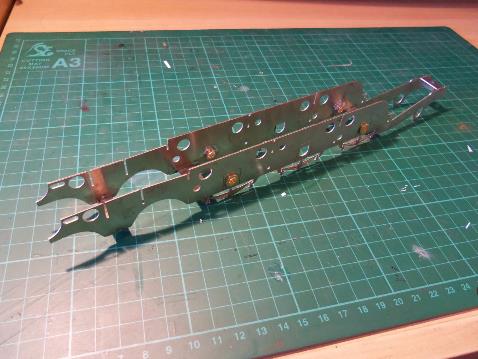
You can clearly see the narrowing of the frames in this photo.
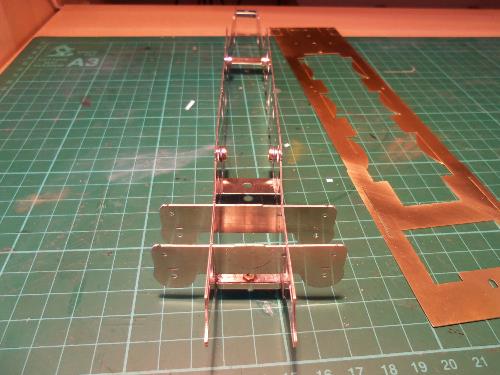
This is going to be fun, putting the two curves into the one piece footplate!!
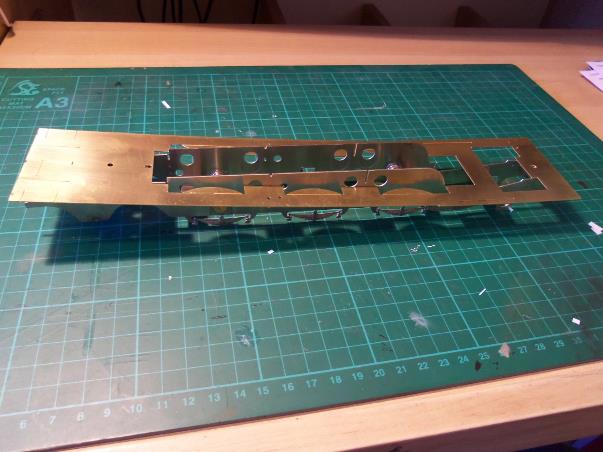
Sandy
Raymond Walley - Jul 25, 2017 at 1:50 PM
Bending such a footplate will be 'fun' anyway but the better kit manufacturers will have provided some sort of jig to help the process. Good luck.
Sandy Harper - Jul 25, 2017 at 7:38 PM
Hi Raymond
By only removing the etchings above the valance you are left with a sort of jig to work your bends against.
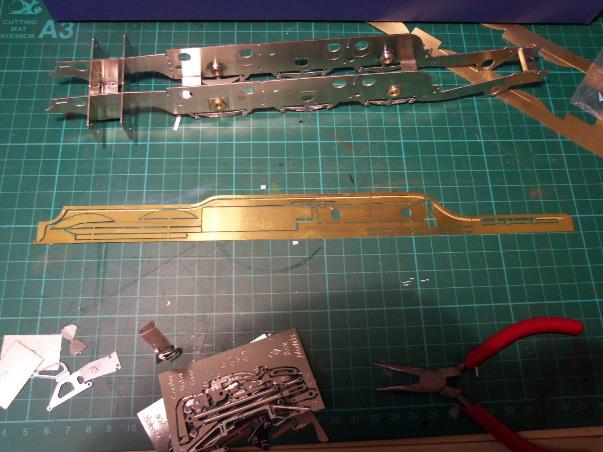
However my more pressing issue is how do I fit the Motion bracket and make it removable?
Here is the bracket partially folded
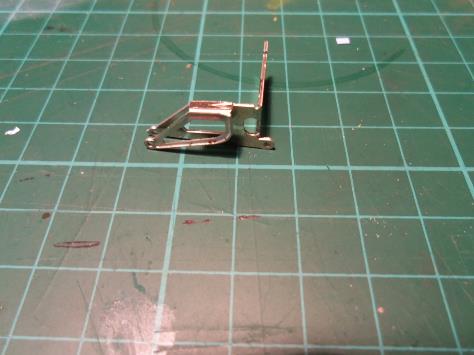
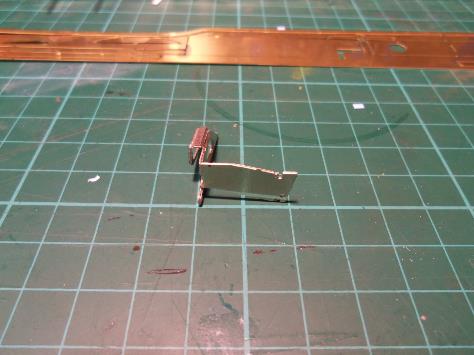
It fits in this location.
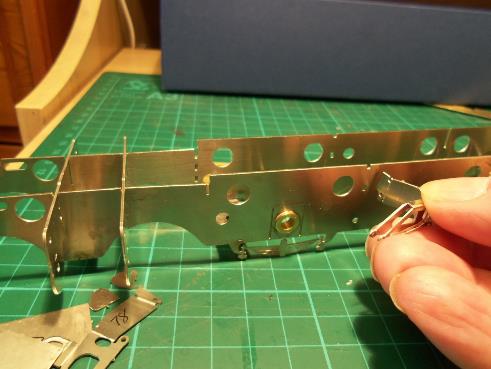
I think I am going to have to remove the metal between the two holes and then solder a bridge piece between the left and right side brackets so that they can be removed together with the valve gear attached. I still don't know what the small etched hole is for?
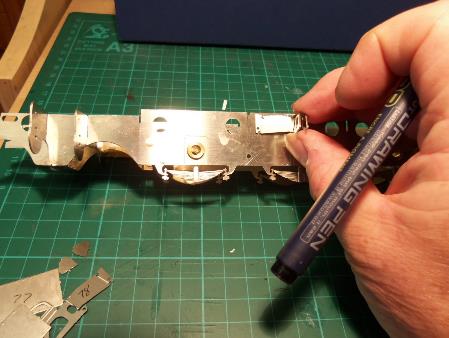
Sandy
Drakeley16728 - Jul 25, 2017 at 8:35 PM
Hello all & Sandy
This will be interesting as the chassis looks the same design as the Ace V2. As for the running plate it's just a case of bending to suit the valance. I didn't find it to much of problem, it's just a case of getting stuck in.
For the motion brackets, look at the Finney 7 V2 instructions, it might give you some ideas.
Regards John
Sandy Harper - Jul 25, 2017 at 9:12 PM
Thanks John, I'll do that.
Sandy
Sandy Harper - Aug 1, 2017 at 6:26 PM
The footplate was a lot easier to bend up than I had expected . I didn't use any rods etc to create the bends, just my fingers. The area of the bends have a half etched area underneath the footplate which makes the brass very easy to shape by hand. The valance, which I had left in the etch initially, was used as the former to get the shape right. Once the bends were in, the valances were carefully removed, cleaned up and soldered into the half etch locating line on the underneath of the footplate.
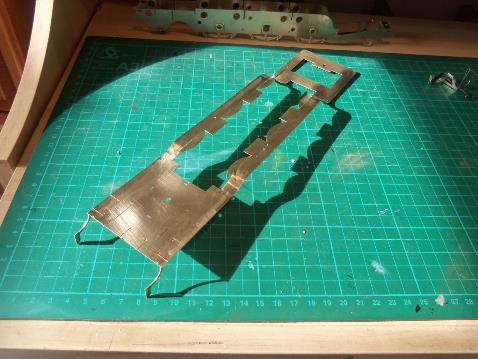
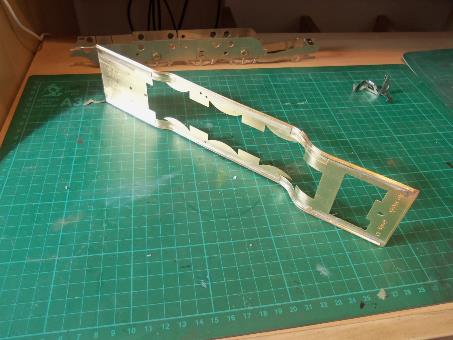
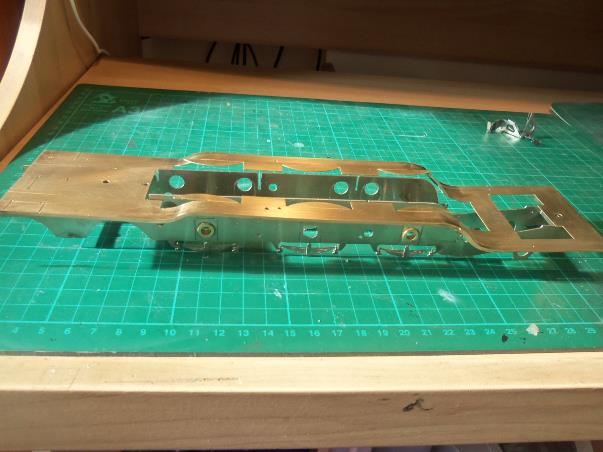
I put together the footplate, at this point in the build, because I suspected that the etch, which folds up to form the expansion block bracket, was too big and would extend outside the footplate valance.
I was right and the photos below show that I will need to remove about 4mm from each of the etches.
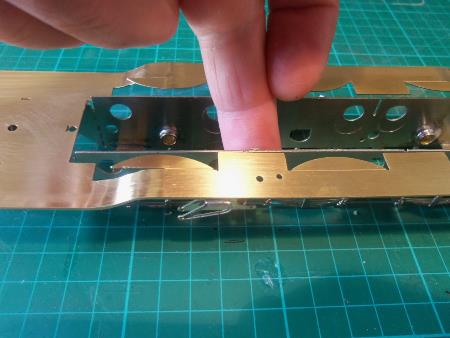
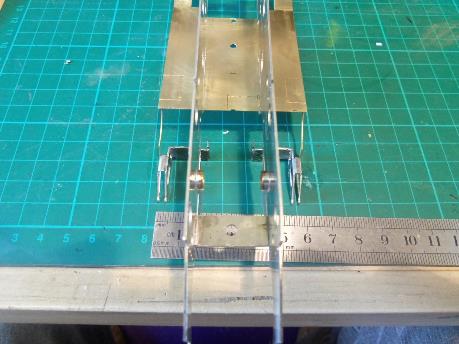
Sandy
Sandy Harper - Aug 2, 2017 at 10:10 AM
Well, it appears that Slaters have resolved the rusty wheel problem! They now coat them in a clear gel type coating which I suspect will need cleaning off before use.
Motion brackets now located.
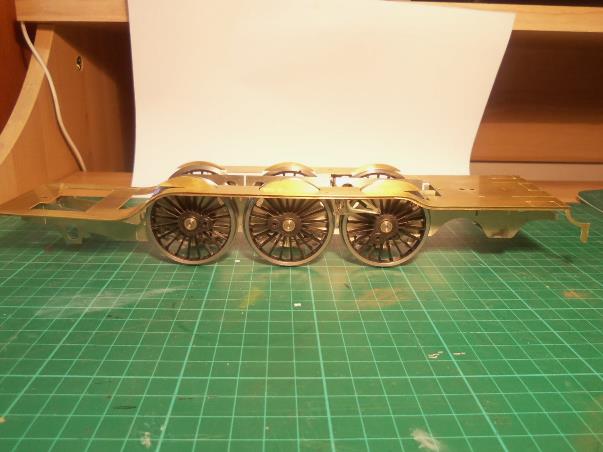
but, I think I am going to have a few clearance problems with the rear drivers?
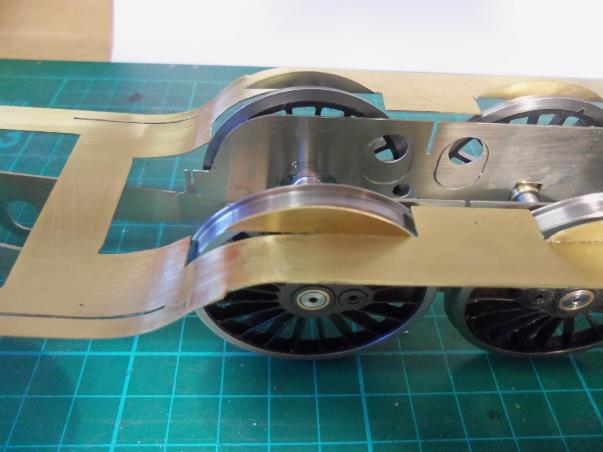
Regards
Sandy
Sandy Harper - Aug 6, 2017 at 1:28 PM
I am pleased with the last two days efforts to get the motion brackets attached, in the correct place, and the cylinders and slidebars erected. This was not without issues, as you would expect! Using the etched slots in the chassis frames to locate the front and rear plates of the cylinders looked straight forward until I attempted to fit the cylinder wrappers. They were nicely etched in N/S with edge bolt detail but, were too narrow to fit around the front and rear of the cylinders.
Decision time. Do I make new wrappers or move one of the spacers? I decided to assemble the cylinders, as a unit, off the model and to fit the wrappers as they were and adjust the sots in the chassis to fit. I also made the decision to make the cylinder unit removable (not catered for in the kit).
The cylinder wrappers needed annealing as there was a 90 deg. bend at the top with about 1.5mm of turnover, another slight bend half way down the cover and then curved for the rest of the wrapper. Annealing made the bending and fitting very easy but left the N/S tarnished. It will probably help with paint adhesion later.
I decided to adjust the front slot in the frames and had to take off about 1mm to get the unit to fit. This can just be seen on the photograph showing the front of the cylinder block. By fitting a vertical spacer in front of the front cylinder cross piece, I have managed to disguise the gap. I drilled this spacer 2.2mm clearance for a pair of 8 BA bolts and drilled (1.8mm) and tapped the cylinder spacer 8BA to secure the cylinder block.
The slidebars and crosshead units are from the Laurie Griffin range and were included in the kit when I got it so, it seemed churlish not to use them! They do need a lot of fetteling up to get a nice sliding fit, using needle files, grinding discs and abrasive rubber wheels in the Dremel and once soldered on to the rear of the cylinders look the part.
Now that I have got this far the rest should be straight forward, if the outside motion fits ok. But of course it will!
Regards
Sandy
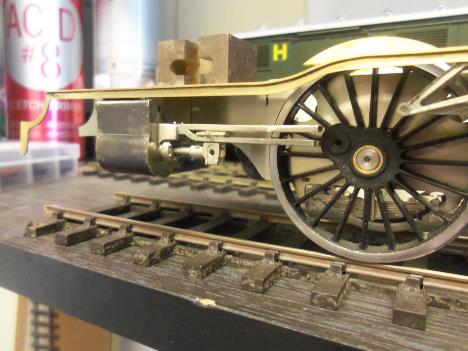
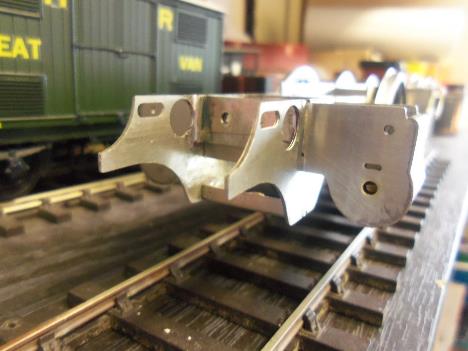
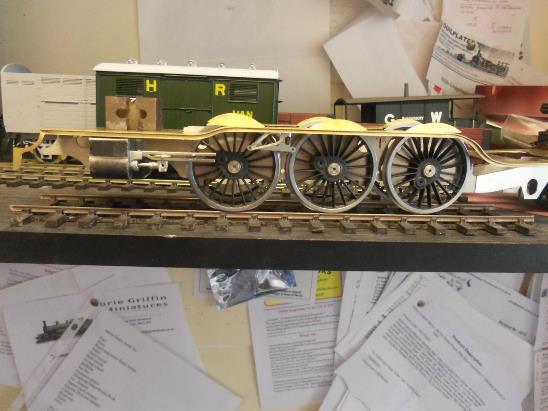
Sandy Harper - Aug 10, 2017 at 11:57 AM
Again, apologies for the rubbish photo!
I was right, the reversing block was probably a good idea on the CAD screen at the time but in practice, not so.
The rear part of the 'block' is separate from the front face and is designed to have 'tabs' ,top and bottom, bent over at 90 degrees to fit in a slot at the bottom of the outer face and a recess at the top. The half etching failed to etch properly o the rear face so I used a triangle file to create a half etch bend line but, even when I managed to fold the tabs over , they were too short and did not give the clearance needed between the two faces of the block.
I used some scrap etch top and bottom and soldered the lot up. I like to put my valve gear in forward drive so used a 12 BA bolt and nut to hold the rod below the pivot point. It will be held in place when the reversing drop link is attached.
Regards
Sandy

Buckley10339 - Aug 10, 2017 at 6:38 PM
Sandy,if i were you iwould replace it with the Laurie Griffin ones they are much much better.I use them on all my LNER locos with the exception of ones that came with two newer DJH kits that were lost wax and looked allmost like Laurie Griffin ones.Its not worth using the Ace ones as with all due respect despite your modifying they still look C–P.Please throw them in the bin !Allso the pins i use to anchor them are small bits of .8mm piano wire that then looks allmost like the real links.you could allso use the cast return cranks as they can be tapped 12ba and simply screwed onto the crankpin and secured with a dab of solder.I keep a stock of essential parts like that as they not only make a visual difference to the model but they work better as well.
Pat.
Round18052 - Aug 11, 2017 at 9:16 AM
… yes I can recommend the Griffin ones.. My DJH ones were a nightmare to fold up and were discarded in favour of cast ones. These are on my Ivatt 2mt. Sometimes you have to admit defeat and go in another direction, to get back to where you want to be !! Dave ( Shottesford Dave)
Drakeley16728 - Aug 15, 2017 at 8:07 PM
Hello Sandy & all
Looking at the photos so far the A3 kit is basically the same as the Ace V2 as you have mentioned previously. This being the case I assume some of the etches are the same. One thing that stands out on the V2 is that the firebox washout plugs are in the wrong place also the hand rail knob holes don't line up with holes in the boiler
This is a problem and I think I will have to make another. I hope you don't have the same problem.
Regards John
Peter Cross - Aug 16, 2017 at 3:33 AM
The easiest thing to do is to solder some round wire or rod into the holes and redrill in the right place.
Sandy Harper - Sep 11, 2017 at 6:16 PM
Steady progress on the footplate has been achieved in the last few days in fact, surprisingly good progress considering!
All driving wheel splashers fitted without too much grief, raised plates over the cylinders fitted perfectly and even the complicated smoke box saddle was built without tears. I did have to rivet the top plate though, as it is just a plain etch. Looking at photos it would appear that some locos had plain plates, but I did want a riveted one so they had to go on.
Still a bit of tidying up to do but actually quite pleased so far!
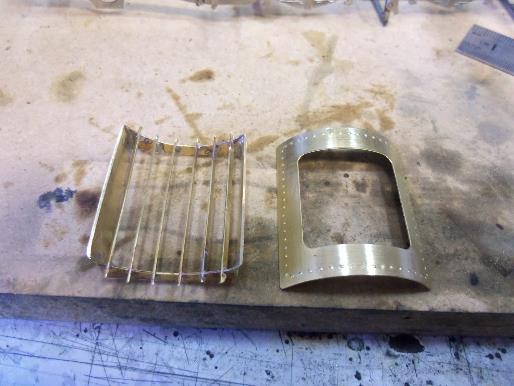
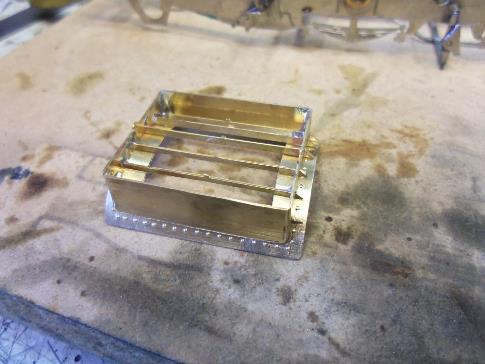
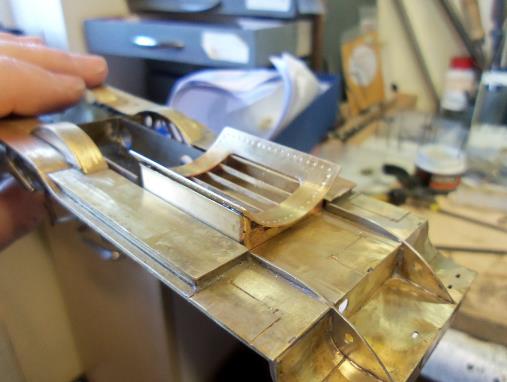
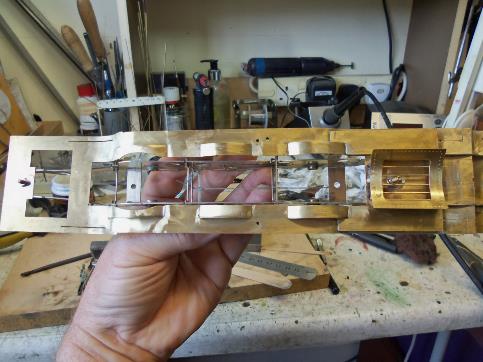 ]
Sandy
]
Sandy
Sandy Harper - Sep 24, 2017 at 1:36 PM
Sorry for the lack of postings on this 'beast' recently, but the only working camera in the house had to go to Alicanti for a week. I didn't get invited to go with it! Girlz only!!
So I managed to crack on with the upper works. And what fun I had. They have been built and 'blowlamped' three times before I got them somewhere near right!. However, despite WA's best efforts I think I now have something that is beginning to look like an A3.
It all started with the cab sides which I decided to put together in the flat. There is beading, handrails, window surrounds and the sliding inner window frames to be added. All was going well until I realised there were no inner frames in the kit of parts! A phone call to WA and I had them in two days! However, after finding a nice photograph of Flying Scotsman with the driver hanging out the cab between the engine and tender I noticed that the cab ends curve in!!!! Nobody told me and there was nothing in the instructions about it! Silly me, fancy expecting a detail like that. Anyway after some judicious setting up in the vice with bars etc I managed to put a bend in the cab sides and without damaging any of the previous work.
At the top of this post I said that the boiler unit was a bit of a trial. After saying in a previous post that the smokebox saddle was a pleasure to put together, I found that it was sitting 1.5mm too high tipping the boiler unit up. So off it came and the requisite amount of brass removed before refitting and getting the smokebox and front part of the boiler level. It was then plain sailing, through a Hurricane, to get the rest of the boiler and firebox attached together and finally fitted to the cab front.
At this point I noticed that the handrail knob holes did not line up. Was I surprised? No, of course not. So a length of 1.2mm rod was tinned and soldered into the holes, filed flat and polished smooth. Then the new hole locations, were marked and drilled, ready to accept the handrails and knobs.
The joints between the front part of the boiler and the coned portion, and between that and the firebox, were not perfect and I didn't think that my usual tape boilerbands would suffice so to hide them so I decided to use the brass boiler bands supplied. The area at the vertical shoulders of the firebox, where it joins the coned part of the boiler, still needs to be attended to as there are some gaps with nothing in the kit to fill them!. No surprise there.
The photograph shows the story so far and the whitemetal parts and just placed on to give effect!! The missing boiler band will be fitted after the dome is attached. The cab is vertical, it's the cameraman that's not!!
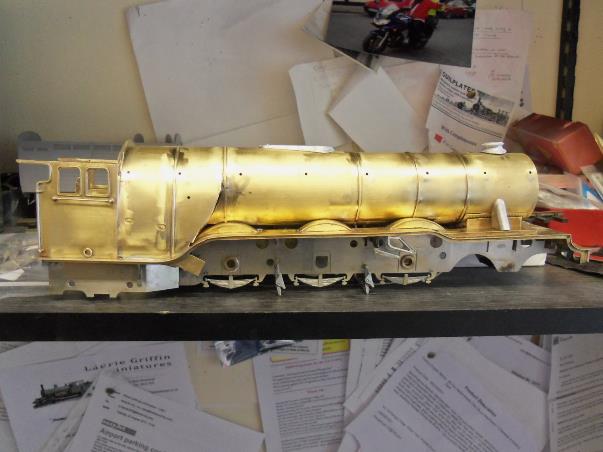
Regards
Sandy
Sandy Harper - Oct 1, 2017 at 9:27 AM
Any similarity to the prototype is purely accidental!
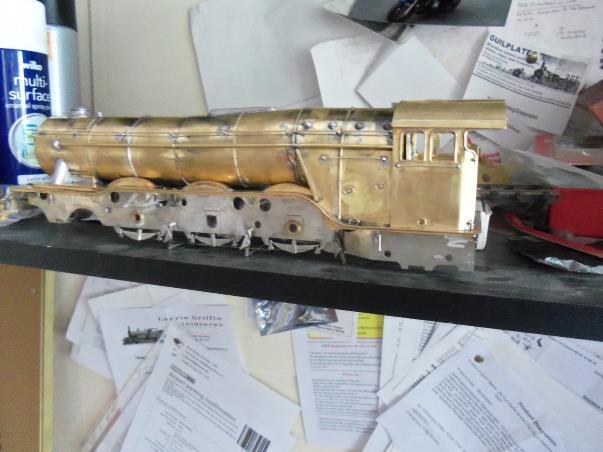
Buckley10339 - Oct 12, 2017 at 10:43 AM
Sandy,i donnt know how far you have come with the valve gear since i told you about the Laurie Griffin bits but i have just found a set in a kit i havnt looked at for a while so here is a photo one pack does both of them.
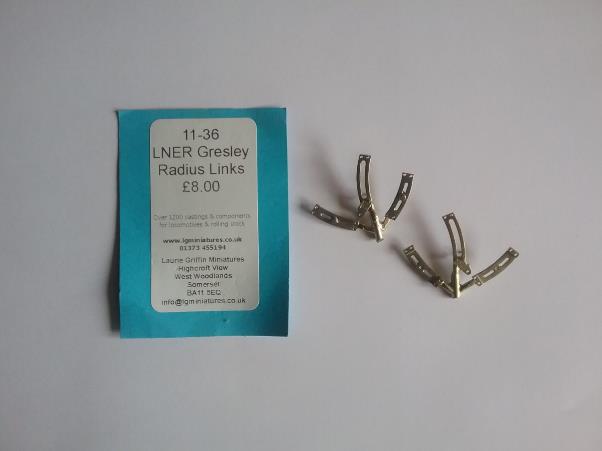
Buckley10339 - Oct 12, 2017 at 11:32 AM
Sandy, forgot to say that if your Ace valve gear only has a single thickness etch for the valve rod instead if a more usual two thicknesses you will not be able to fork the rod to fit in both the slots of the link as per prototype.The solution i used was in leu of making doublers up to fork the rod was to just put the single etch in the outside slot of the link and pretend the other was there.In all three of my Acs kits there is only one etch thickness for all the valve gear which is a bit of a pain to say the least and as all three use the same LNER valve gear i will have to do the same with the other two that need doing.Talk about spoiling the ship for a bit of tar ! Let us know how you get on with it i may be able to help if you hit a tricky bit.
Pat.
Sandy Harper - Oct 17, 2017 at 9:03 AM
[ATTACH=full]4508[/ATTACH] Cheers Pat, thanks for the info. As all the etches from Ace seem to be individual, ie not a set! therefore it should be possible to obtain extra valve gear etches from WA if you need them. The valve gear has been built, fitted and dismantled again, for painting the chassis. I have finished the loco body and have now set to trying to knock the tender into shape.
Regards
Sandy
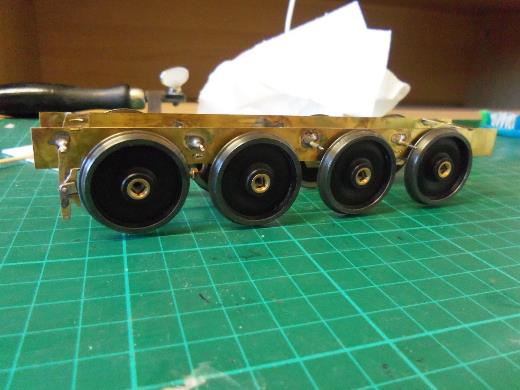
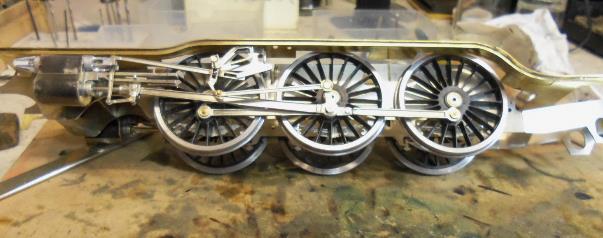
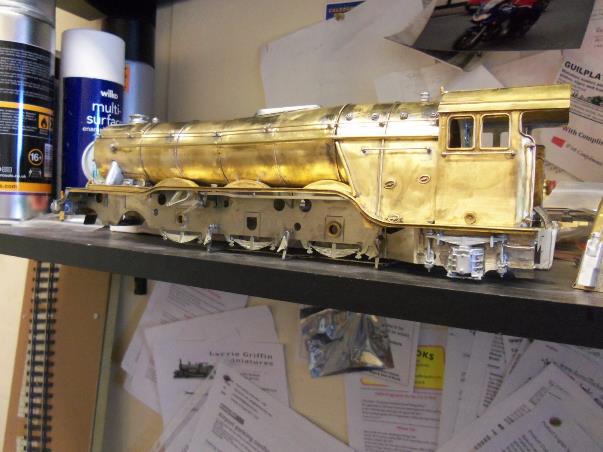
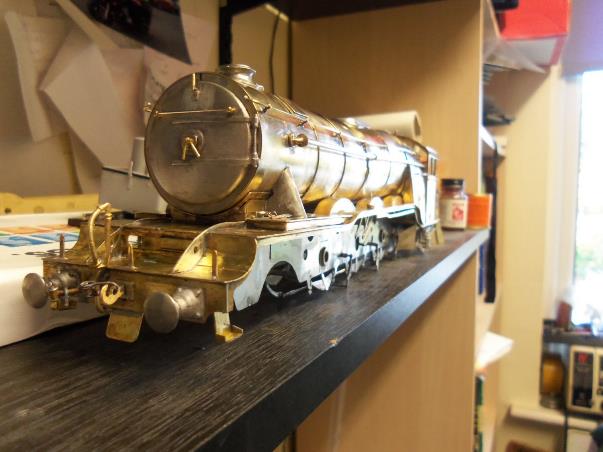
Sandy Harper - Oct 31, 2017 at 12:07 PM
Much like the locomotive the GN tender kit has it's good and bad points. Mine was supplied with bits missing and a number of extraneous parts that were not required so be prepared to do a bit of simple scratchbuilding. I needed to make a drag beam and two extra lamp irons. I had previously contacted ACE about some missing Loco parts but you are expected to send a stamped address envelope to have them sent to you!! I didn't bother this time!
The Tender chassis is supposed to have a compensated rear axle but there is no compensating unit included as part of the chassis etch so it is a scratch build exercise if you want to fit one. Tab and slots to assist with the fitting of the tank to the footplate don't line up. No surprises there then?
The coal rail , although nicely etched, is too long for the tank! Cut and shut needed here. The castings for the springs and axle boxes are good quality but the brake standard and the water scoop operating standards are too short, and there is no water scoop included. The buffer housing square flanges 'just' manage to cover the enormous holes in the buffer beam. Care needed here when soldering them up.
As with the locomotive cab instructions there is no mention of the curve in the side sheets at the entrance to the footplate. You have to supply your own wire for the handrails and brake rodding. Nothing included in the kit.
The main build is now almost complete and it will shortly be going to the Grit Blasters to have it prepared for painting.
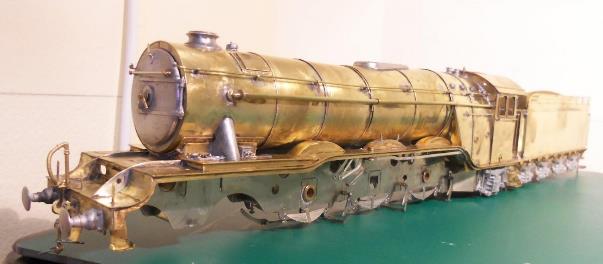

Regards
Sandy
Raymond Walley - Oct 31, 2017 at 1:23 PM
Good work Sandy, must be satisfying to have overcome all those problems.
Sandy Harper - Oct 31, 2017 at 3:50 PM
Hi Raymond, there was nothing satisfying about this build, all grief!:mad::mad:
Jim, it is always a fraught time after painting. Nothing ever fits as it used to!!:(:(
Sandy
ChrisSimpson - Oct 31, 2017 at 4:09 PM
I've found that as well. I make sure my models work before dismantling to paint, then the damn things won't go back together again. I don't think I use terribly thick paint, but for the next one I'll use the skip of my bonnet as a feeler gauge to ensure enough clearance.
Seriously Sandy there is a greater satisfaction in getting a poor kit together despite the grief. I've done a few, and will quite happily take on someone else's disaster.
Chris
Sandy Harper - Nov 6, 2017 at 5:47 PM
Grit blasted, washed and ready for primer, when the weather is suitable.
Sandy
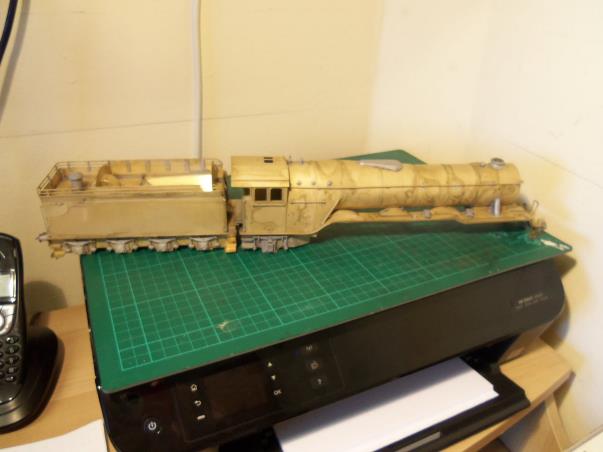
Sandy Harper - Nov 19, 2017 at 9:00 AM
After such a messy built I like to do something simple like a couple of waggons but this time It was a Sentinel Y1 8400. It took approximately 10 hours to complete and was a joy to build. I don't have a photo of the completed loco yet but I will post one on the forum next week.
The A3 is progressing through the paint shops and is presently drying after a second coat of BR green.
Regards
Sandy
Sandy Harper - Dec 7, 2017 at 4:10 PM
I am taking a short break from gluing the 'plastic box' to complete the ACE A3.
The lining and cab side number transfers have been added from the Fox range and the splasher beading and valance will be lined out in 'Precision Lining Orange' using a offset lining pen, There is still some detail painting to be completed, but the end is in sight!
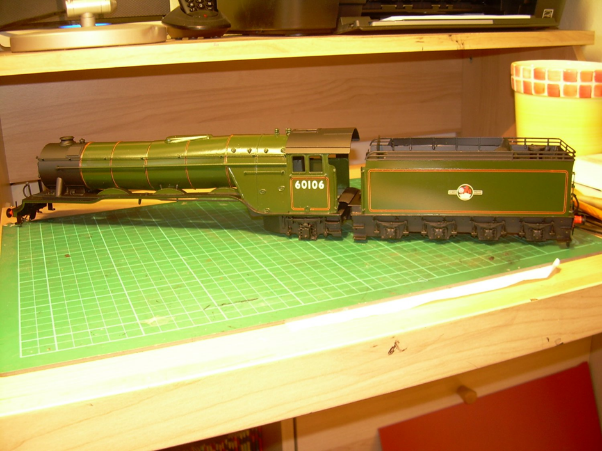
Regards
Sandy
Drakeley16728 - Dec 8, 2017 at 9:58 AM
Hello Sandy
The painting of your A3 looks very good. Seeing you have painted it at a time of year when a lot of people, myself included, would wait till summer I would be interested to know your technique and the paint you used.
I ask this because painting for me is always a problem. Building engines or rolling stock, no problem at all, but then it comes to painting and all changes.
I am more or less at the finish of my Ace V2 so to read what you did with your A3 would be a help.
Regards. John
Sandy Harper - Dec 8, 2017 at 10:49 AM
Hi John,
My modelling room/workshop/paintshop is the small bedroom in our 3 bed semi. It is useless as a bedroom anyway as it is too small. When I need to paint I have to erect a folding camping table in front of my work bench and I set up a portable spray booth on it that I got from Eileens a couple of years ago. It has an extractor fan and a hose that I hang out of the window to remove the fumes. I obviously don't paint if it is very moist outside but the central heating radiator in the bedroom keeps the air inside warm and dry and I can paint in most conditions.
I tend to use enamel paint, Precision and Humbrol, and Halfords undercoat, and thin the enamel with odourless white spirit from B&Q. Varnishing is done using Ronseal Polyurethane Satin varnish.
I have a compressor with a small tank and regulator so that I can spray at a constant pressure, usually about 18 PSI, and use a pair of Badger 200 single action brushes.
I keep the door to the rest of the house closed when spraying and wear a mask. Nothing sophisticated about it but it works for me.
I hope this helps but, if you need to know anything specific, please feel free to ask.
There will now probably be an avalanche of posts on how other members do it, so you should be able to pick out the the bits that suit you.
Kind regards
Sandy
Drakeley16728 - Dec 8, 2017 at 3:47 PM
Hello Sandy
Very helpful to know how you overcome the winter when painting an engine.
I have a similar set up, third bedroom used as an indoor workshop but I haven't thought to use it as a paint shop. The way forward is to buy a spray booth with extractor fan then I'll give its go.
Some years ago I utilised the kitchen with the extractor fan on full to paint a loco but only the once. I covered all the work surfaces and floor with paper to prevent any over spray getting on then but the leader was not to impressed. Hence only the once.
Regards. John
Sandy Harper - Dec 13, 2017 at 6:40 PM
Static test on the rolling road today proved successful but, a trip around the club circuit tomorrow may show up some bogie shorts. Fingers crossed it doesn't!
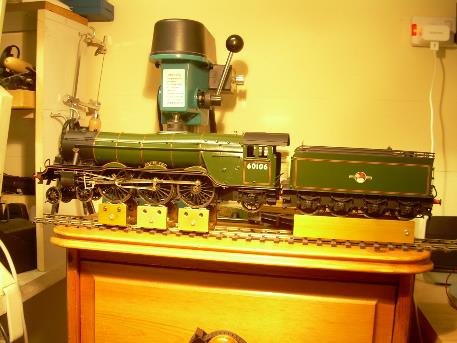
Sandy
Sandy Harper - Feb 7, 2018 at 5:14 PM
A run around the club test track did throw up a couple of issues.
The restraining spring wire, at the rear of the bogie was too stiff. The tender springs, on the two middle axles, were also too stiff and the middle drivers were touching the inside of the splashers causing shorts.
The Bogie wire was replaced with a thinner one. The tender springs were 'bent up' a bit to reduce the downward pressure and a spacer was inserted between the loco chassis and foot plate to allow sufficient clearance for the wheel flanges to avoid the inside of the splashers.
Just needs a blow over with some varnish and a load of coal.
Regards
Sandy
End of Thread.
There is a lot of further discussion on this forum thread on Kit quality etc. Not really relevant to this construction, but it can be read on the original forum thread. T.D.





